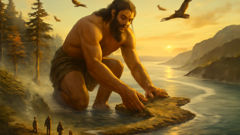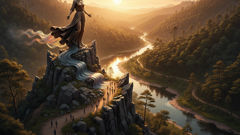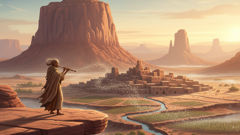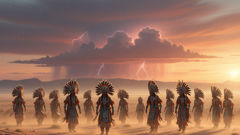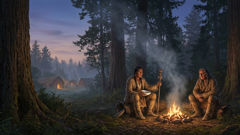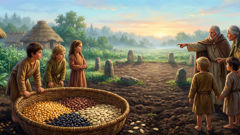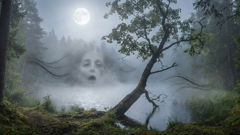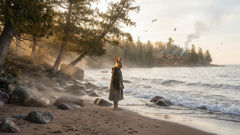Introduction
At the edge of the world where cold ocean meets red pine and river, the Wabanaki people have always named a great maker and a mischievous friend: Glooscap. He arrives in stories as both gentle and fierce, a being who shaped coastlines with the sweep of his hand and setting the first rules of living with a smile as quick as a gull. To hear this story is to stand where ancient tides left striations in rock, to see the first ponds carved into bedrock, to feel the hush when wolves and eagles listen at the same time. The tale of Glooscap is not a single neat event but a braided song: creation and laughter, warning and counsel, the origin of mountains and moose, of canoe and drum, of star and storm. In the Wabanaki world he is a teacher—sometimes a trickster—whose actions made the islands and rivers safe for people and who taught them how to hunt, make fire, heal, and speak respectfully to the living world. This retelling moves with the patterns of the Northeast seasons, with fog and frost, with spring melt and berry summer. It brings scenes of land-making and of smaller, tender lessons: how children first learned to listen to wind, how women learned medicine from the bark of trees, how boys learned to read river signs. While Glooscap can be a prankster—turning rivals into stone or shaping cunning obstacles—his larger purpose is to set balance: to protect the small and to correct the greedy. The legend that follows offers vivid images of shaping shores and setting rules, keeping cultural reverence at its center and inviting modern readers to understand a sacred geography where language and living land are one.
The Shaping of Coast and Forest
Glooscap begins where the world is mostly water and unnamed memory. The first account tells of a time when the sea covered much of the rocks and only the highest peaks pierced the gray horizon. In that silence, Glooscap moved like a dawn wind, patient and purposeful. He walked east along the shore, reached down into the water, and drew out the first stones with hands the size of canoes. He stacked them with the care of someone building a hearth, and islands rose—rounded, wind-buffed, full of eider nesting places and soft moss. Where he scraped with a stone knife, he left river beds; where he pressed his palms to the earth, peat bogs gathered rain and kept the memory of seasons. Each gesture was a lesson in form, showing people how to look: you can read a coastline like a story if you know where the tide loved to rest.
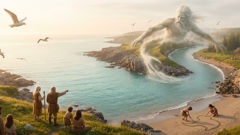
The land that resulted from Glooscap's working is a landscape of utility as much as beauty. He carved channels so fish could run in spring and be caught in the fall. He pushed boulders to make rapids so that young men might learn to listen for the water's voice. He hollowed out coves and sheltered bays so villages could keep canoes safe from storms. In doing so, he taught a secret of stewardship: shaping the world is also an act of care. For every bay he deepened, he left a cliff for the hunter to climb and a kettle hole for the beaver. He planted forests by pointing to where seed should fall, and ceded good berry patches for women to gather. This was not a single act of dominance; it was iterative and generous. When a place asked for change, Glooscap answered with a touch and a hum.
There are stories that show how practical learning came from these shaping acts. Once, a thin spring threatened famine as ice choked the river. Glooscap beat his drum and called the thaw early in spots, sending water to pools where fish could rest. He taught the people to build weirs, to set stones in patterns that allowed salmon to climb and be taken without starving the run. He taught them the measure of taking: only what will feed your family today and leave the stream enough to spawn tomorrow. In another tale he fashioned the first canoe: tapping a cedar until the tree loosened a great length of its heartwood, then hollowing and burning with a rhythm that kept the wood from cracking. That canoe became a tool and a teacher—how to keep fire close to craft, how to listen to sap and grain in wood, how to respect cedar as a kin-tree who gives.
Yet the shaping of land also required compromise. Glooscap encountered creatures who resisted change—giants of the deep, spirits of old hills, and transformed beings who had been tricked once and remembered their anger. One ancient being refused to yield a fertile valley. Glooscap did not simply force it; instead he told a long story, halted in the valley's entrance, and made the old guardian laugh. Laughter in these tales is not mere amusement but a release; it breaks the hardness of resistance. When the guardian laughed, it softened, and the valley opened like a flower petal to new use: brookside meadows for children, reeds for basketmakers, deer paths for hunters. This demonstrates a Wabanaki principle woven into the legend: the world responds when you balance strength with humor, firmness with respect.
Beyond practical advice, Glooscap mapped a cosmology that connected the earth to the sky. He climbed a ridge high enough to touch the stars and asked the heavens what each light was for. The stars answered in voices like cold iron and warm honey, and from that conversation Glooscap taught people the names of constellations that guided winter travel and summer planting. He put a pattern in the night that matched the river's braid and the migration of geese. Children who learned these patterns could anticipate the weather and know when to trade goods or gather for migration. So the land is also a timekeeper, and Glooscap's shaping of the land engraved a living calendar.
The coast's shaping also included the subtle hand of law: Glooscap decreed that the tide would mark the boundary of where one could take shellfish, setting a rhythm for harvest that kept clam beds healthy. He instituted nights of silence and vigil to honor animals' spirits before killing them, and he taught songs that needed to be sung to return thanks to a salmon's spirit when it was placed on the fire. These stories, repeated at winter fireside and summer feasts, became the scaffolding of a moral ecology: to live well you must understand how your needs fit into a web. Glooscap's landscape is not inert backdrop but teacher, and his shaping was a curriculum of living.
The physical world in these tales teems with character. Moss is thick with memory; stones remember where they were born; rivers have temperaments you can learn to read. Glooscap is portrayed as sometimes impatient—he could stamp and make a hill or be gentle as he coaxed a cedar. In his impatience he would sometimes create mischief that later had to be corrected: gulls were given loud cries because he laughed so hard he snapped his fingers and a small flock caught his mirth; muskrats were given strong teeth because they chewed through some bindings Glooscap left by mistake. These small acts give the world its diversity and are why elders say Glooscap's faults are part of his gifts. He is not a remote god but a presence in the same world as fishermen, midwives, and children learning to paddle.
To trace these stories fully is to trace a living map of the Northeast: each creek has a story of how Glooscap dug it, each island remembers his footprint, and each berry patch hums with the echo of his song. Those who listen—whether by long line of descent or respectful curiosity—hear the land speak, teaching how to live in reciprocity and gratitude.
Glooscap's Trials and Teachings
If the first part of Glooscap's work is creation, the second is instruction. The Wabanaki myths show him in countless encounters with beings who tested his kindness or provoked his cunning. These trials reveal how Glooscap turned conflict into ceremony and misbehavior into lesson. Several of his adversaries are not merely enemies but living contradictions—creatures that challenge the community's survival or individuals who have grown too proud; each confrontation is an opportunity for a rule to be fixed into place.

One recurring antagonist is a figure of unbridled appetite—a giant who devours indiscriminately and upsets the fragile balance of food availability. In that story, Glooscap must teach restraint. He approaches the giant not by blunt force but by cunning. He bakes a bread that seems endless, a loaf so wide and tall that the giant’s eyes bulge. The giant eats and continues to eat until he has no room even for greed. Glooscap then tells a small parable about a river that can flow only when its banks are not clogged. The giant realizes his eating empties the rivers of fish and the forest of game, and to show penance he plants his first tree. The tale is a direct lesson: greed breaks webs and work must be done to put things right. Glooscap’s correction mixes humiliation with practical restitution—a way of restoring cycles.
In other episodes he faces beings of trickery—foxes that talk in clouded tongues, spirits that steal sleep, and even kin who were once rivals. Against these he uses stories within stories, parables that unmask the real nature of greed and deceit. Many of Glooscap’s teachings are delivered as demonstrations, not lectures: he shows by example how to outwit a storm, how to bind wounds with herbal poultices, and how to interpret the language of birds. In one telling, he imitates a loon call so precisely that a stranger who sought to take too much from the village is led into delight and then invited to sit at a working hearth. There, the stranger learns the rhythm of communal labor—how to make nets, split roots, and stoke community fire. Being integrated into the community becomes the punishment and the cure.
Glooscap also addresses the profound sources of human fear: loss, death, and the unknown. There is a notable account about how he met the child of a grieving mother who could not accept the seasons. The child chased the white of winter until frost snapped the young willow—refusing the slow lesson of rest. Glooscap took the child on a journey to the deep of the earth, where he spoke with the sleeping roots and the stones that hold cold. He taught the child to trust cycles: seeds die in winter to rise in spring; the deer thin to preserve herd health; even grief thins to make room for memory. When the child returned to the mother's hearth, she no longer fought the season but made space for remembrance and celebration.
Beyond the transpersonal, Glooscap is intimately concerned with the building of social forms. He sat with elders to craft the first protocols about sharing across kin lines and how to welcome strangers respectfully. He set the patterns for conflict resolution that refused permanent exile as a first measure; instead, he suggested rituals of reconciliation, where wrongs are named and mended by collective work. A man who stole a canoe might be required to repair every damaged paddle in town; a woman who spoke false words in a council might be given a season of service to the old people. These were not punitive acts aimed to humiliate but set as practical restitution that healed both the victim and the offender by reweaving their place in a community net.
In his trickster role, Glooscap sometimes tests the pride of young people. A boy boasting he could run faster than the river was given a jacket that made him light as wind. The jacket sent him skimming across surfaces until he could not stop; he skated into cold eddies and feared for his life. Only by admitting fear and asking for help did the jacket relent. This tale teaches humility and the value of asking for help when necessary, a powerful antidote to dangerous pride.
The stories of Glooscap’s teaching also have a strong feminine counterpart. He honors women as keepers of medicine and memory—often in tales where women correct Glooscap’s mistakes with calm insight. In a narrative about overfishing, it is a woman healer who instructs Glooscap on a ritual to restore the run: she gathers salt, kneads dough into an offering, sings a song of release, and scatters a careful handful into the river. Glooscap learns not to assume authority where local knowledge reigns; he learns to listen. The patient work of women in these stories—of basketmaking, midwifery, and plant lore—is central to community continuity. Glooscap's respect for those skills anchors him as a teacher who is willing to learn.
Some tales explore the tensions between modern curiosity and ancestral ways. As strangers arrive in later legends, bringing different tools and faster ambitions, Glooscap negotiates between keeping the old ways and allowing useful change. He is wary of anything that uproots reciprocity. Once, a metal blade—shiny and alien—was offered by a trader in exchange for unlimited fish. Glooscap warned of sharpness that cuts not only meat but the ties that bind. He suggested moderation: use the blade for tools, not to clear entire runs of fish. These stories feel particularly relevant now, speaking to contemporary concerns about resource extraction and cultural survival.
Yet what underlies all his actions is a deep ethic: living well requires listening to the more-than-human world and answering with generosity. Glooscap models a form of leadership that blends authority with service. When he is angry, his anger aims to repair; when he plays, his play opens the possibility of new learning. Violence is rarely the first tool; humor, story, and patience come first. In that way, the legend teaches not only how rivers were dug or how drums were made but how to be caretakers: to watch, to repair, to continue.
At hearths where these stories are told, elders remind young listeners that Glooscap’s voice is still in the wind: in the shape of islands, the chorus of loon on a foggy morning, the careful art of a seam made for a canoe. To know Glooscap is to know the rules and the ways to keep them alive through song, gesture, and labor—an ethics of place that endures when people continue to listen.
Conclusion
The Legend of Glooscap remains a living scaffold on which Wabanaki peoples recall how to be part of a place. Glooscap is not simply a maker of land; he is a teacher who shows the small, ordinary practices that knit communities to the living world—how to harvest with restraint, how to reconcile after harm, how to speak to a wounded animal spirit and return thanks. The tales encourage an ethic of reciprocity where land is kin and story is a practical guide. They also hold a humility at their center: a reminder that the human role is not to dominate but to steward. In contemporary times, when coasts are reshaped by climate and choices about resource use feel urgent, Glooscap's lessons remain powerful. They ask modern readers to pay attention to cycles, to hand skills and songs to the next generation, and to treat the world with careful generosity. The legend endures because it speaks both to wonder and responsibility—because a coastline that remembers its making will teach those who listen how to live in ways that keep the web of life intact. To tell this story is an act of keeping: passing on memory, calibrating gratitude, and offering the possibility that when people listen closely—like children learning the sounds of river ice—they can answer the world with skill, care, and a story worth telling.

